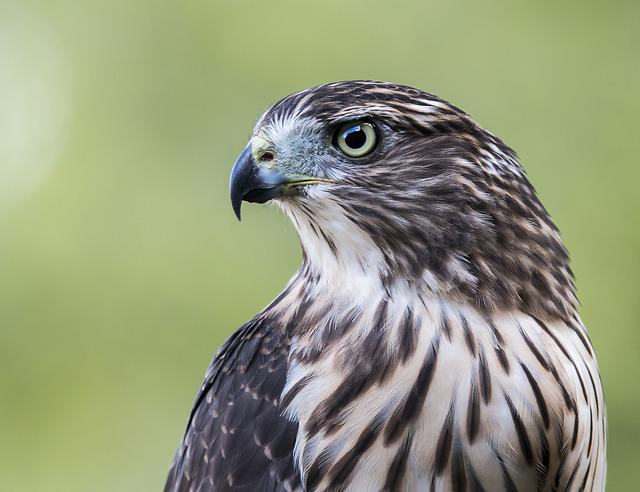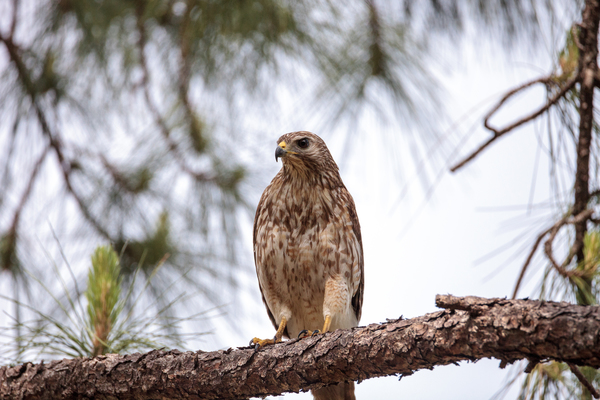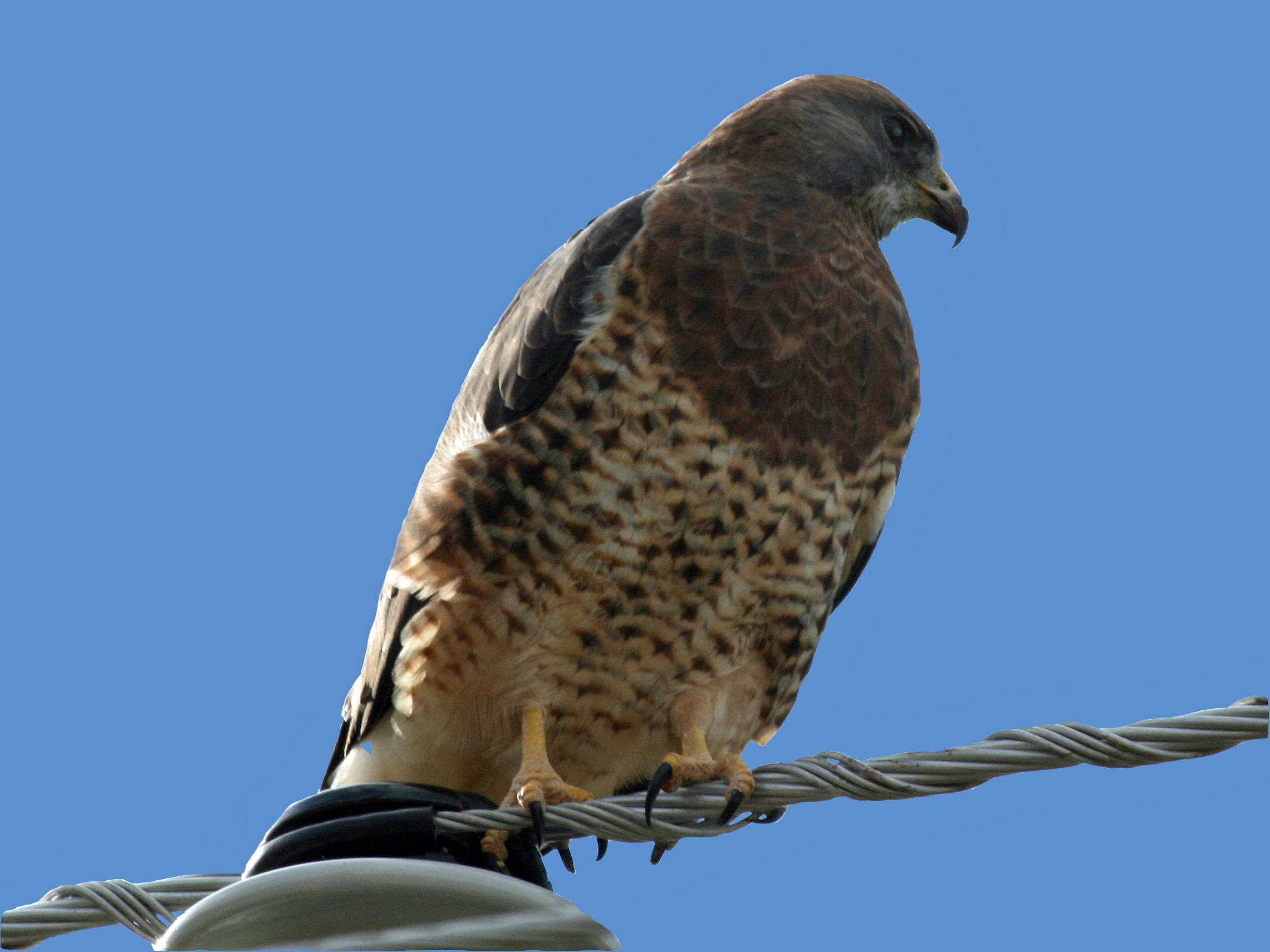The birds of prey are also known as raptors. These raptors include Hawks, Owls, Falcons, Eagles, and Vultures.
The Hawks that perfectly prefer to live in Ontario due to its climate and food availability are mentioned in this article.
| Image | Name |
|---|---|
 | Red-Tailed Hawk |
 | Sharp-shinned Hawk |
 | Coopers Hawk |
 | Broad-winged Hawk |
 | Rough-legged Hawk |
 | Red-shouldered Hawk |
 | Northern Goshawk |
 | Swainson's Hawk |
 | Ferruginous Hawk |
Birds of Prey in Ontario
1. Red-Tailed Hawk

The scientific name for the red-tailed Hawk is Buteo jamaicensis.
These raptors weigh about 688 – 1460 grams the, have a length of about 17 – 25 inches, and their wingspan extends from 44 – 52 inches Red-tailed Hawks have a recognizable short, broad red tail, as their name indicates.
Habitat
They have big, rounded wings and are huge. The majority of Red-tailed Hawks have a brown back and a light underside.
As they circle slowly over vast areas in search of prey, including small animals, birds, and reptiles, they are also the most easily spotted and are frequently seen on lengthy vehicle trips.
They are also positioned atop telephone poles.
Additionally, they can be spotted in habitats including fields, parks, deserts, roadside sand dunes, rainforests, woods, or scrublands.
Nests are located high in rock ledges, large trees, and occasionally on towering structures or towers.
2 – 3 pale, brown-spotted eggs are laid by them.
2. Sharp-shinned Hawk

Sharp-shinned Hawk’s scientific name is Accipiter striatus.
They have a length of about 9.4 – 13.4 in (24 – 34 cm), and these raptors weigh about (87 – 218 g) and possess a wingspan of 16.9 – 22.1 inches (43 – 56 cm).
Appearance
Adult Sharp-shinned Hawks are small hawks with blue-gray across the back and red-orange breasts. They have dark bands across their tails.
The size of the females is one-third that of the males. They have tiny heads, short, rounded wings, and long, square-ended tails.
In Ontario, the breeding season for Sharp-shinned Hawks lasts from August to April.
They leave the majority of the province in the winter and can still be seen in the south. Although they are quite elusive, Sharp-shined Hawks sometimes be observed flying through wide spaces at the margins of woodlands.
They are swift and can move quickly through dense foliage to capture their prey.
Before consuming its food, Sharp-shinned Hawks pull it off a stump or low branch. They often prey on songbirds that are approximately a robin’s size.
The Sharp-shinned Hawk often builds its nests towards the tops of tall trees in areas with deep cover.
With a circumference of 1-2 feet and a depth of 4-6 inches, the nest is substantial in size. They release 3–8 white or pale blue speckled eggs each time.
Check out this article on the Types of Hawks in Ontario.
3. Coopers Hawk

The scientific name of cooper’s Hawk is Accipiter cooperri.
These raptors have a length of 35 – 50 cm and weigh approximately about 8 – 24 oz. or 220 – 680 grams. Whereas their wingspan ranges from 62 – 90 cm.
The Cooper’s Hawk is larger, roughly the size of a crow, and has a striking resemblance to the Sharp-shinned Hawk in appearance.
Appearance
Given that they both have the same blue-gray back, red-orange breast, and dark bands on the tail, it can be difficult to tell them apart.
They resemble the Sharp-shinned Hawk almost exactly, even down to the little black cap that they both wear and the rufous-colored breast.
Unlike the Sharp-shinned Hawk, they have a bigger head that extends well beyond the wings. In Ontario, these raptors are frequently seen in fields or in the forests.
A Cooper’s Hawk’s agility in the air is well recognized.
These raptors are frequently seen in backyards around bird feeders, where they prey largely on songbirds.
They nest in towering trees, frequently on top of an old nest of a large bird or clump of mistletoe, and prey on medium-sized birds and small animals.
They produce 2 to 6 bluish-white to light blue eggs.
4. Broad-winged Hawk

The scientific name for the broad-winged Hawk is Buteo platypterus.
These birds of prey have a length of about 13.5 – 17.5 inches (34 – 44 cm), and they weigh approximately about 16 ounces or 450 grams. and their wingspan anges from 84 cm/33 inches.
Appearance
The Broad-winged Hawk is a small, stocky bird that is between a crow and a goose in size.
They have barred breasts, short, square tails, and reddish-brown heads. The Americas are home to the little raptor known as the Broad-winged Hawk.
The size difference between the sexes is similar to that of other raptors.
The wings of wide-winged hawks are short and broad and seem tapered and somewhat pointed. Adult birds have white bellies and breasts and dark brown bodies. Consisting of horizontal bars.
They can have white lines running through the center, base, and tip of their dark grey-black tail.
Range
These birds migrate south for the winter to Central and South America while spending the summers here in Ontario. Broad-winged hawks are known for their extraordinary migrations.
From southern Canada to southern Brazil, the range of broad-winged hawks in North America and South America is extensive.
They travel to Florida, southern Mexico, and northern South America during the winter months. They reproduce in the northern and eastern regions of North America.
Some subspecies are migratory, yet they are indigenous to the Caribbean. Daytime activity is when broad-winged hawks are active.
They wait for their prey to be noticed while lurking in the undergrowth and watching from low trees.
They glide quickly and briefly from their perch to the prey. These birds take extra care when skinning frogs and snakes, preparing their meal for ingestion, and plucking the feathers of prey birds.
However, most tiny animals are consumed intact. They seldom ever consume water and can subsist entirely on the water found in their food.
These hawks hunt from perches, frequently near water or wooded areas, and they prey on small animals, frogs, snakes, and even hatchling turtles.
The Broad-winged Hawk often lays two to three pale eggs in the nest of another species, such as a crow or squirrel.
5. Rough-legged Hawk

The scientific name for this bird of prey is Buteo lagopus; these raptors have a length of approximately 18.5 – 20.5 inches and weigh about 25.2 – 49.4kgs.
They possess a wingspan of 52.0 to 54.3 inches. Rough-legged Hawks are variable in plumage, with light and dark color phases and variations in between.
Dark phases account for only ten percent of western Rough-legged Hawks. Adults are generally mottled light-and-dark underneath, with dark patches at the wrists. Seen from below, the tails of both phases appear light with a dark terminal band.
The Rough-legged Hawks get their name from their feathery legs, which also keep them warm in the cold.
They are huge hawks, around the size of a goose or a crow. This mostly dark-drown species can be seen in both light and dark versions, with dark spots on the belly, tails, and wing bends.
Compared to other hawks, they have wide wings that are rather long and slender.
Range
Rough-legged Hawks, a species that differs from most hawks in having feathers all the way down to its feet, are more frequently spotted in southern Ontario throughout the winter, from late October to early April.
Prior to wintering in the US, Rough-legged Hawks migrate to Alaska and northern Canada to breed. They are frequently seen perched on a pole or hovering over marshes and open fields.
The majority of the prey for rough-legged hawks comes from lemmings and voles.
In places like West Virginia, tiny animals like voles, mice, ground squirrels, and others serve as winter prey.
They often build their nests on a steep rock ledge and lay three to five light bluish-white eggs in each.
6. Red-shouldered Hawk

The scientific name for this bird of prey is Buteo lineatus. These raptors have a length of about 16.9 to 24.0 and weigh 486 – 774 g. Their wingspan ranges from 94 – 111 cm.
Appearance
Red-shouldered Hawks are easily identifiable thanks to their black and white striped wings and reddish breast barring.
They have a tail that is heavily banded and are medium-sized, between a crow and a swan in size. The shoulders and breast barring of adults are rusted.
The tail is heavily patterned: it is black with narrow white bars and has black and white checkered wings.
When seen from above, soaring individuals have rounded wingtips and a light crescent at the wingtips (in the center of the primary wing feathers).
Young birds have brown upper bodies and are highly streaked. Like other buteo hawks, this one often hunts when perched or flying overhead.
They frequently perch on telephone poles, branches of trees, or even fence posts to keep an eye out for ground activity. When they spot their prey, they either dive right on it or fly in from the flank.
Buteos have a lesser proportion of birds in their diet than accipiters (like Cooper’s and Sharp-shinned hawks) because they are less nimble.
Food
The majority of the diet consists of small animals like mice, but it also includes insects, crustaceans (like crayfish), reptiles, and amphibians.
Nests are often constructed in deciduous trees, below the crown but on the main branch of the trunk, frequently close to water, and can be used for several years in a row.
The nest is built (or renovated) by the female and male form of sticks and lined with moss, leaves, bark, and other softer materials.
Two to five eggs make up a clutch, and they are incubated for a month to roughly 40 days. About 40 – 50 days after hatching, the baby birds fledge. Each year there is only one brood.
7. Northern Goshawk

This raptor has the scientific name Accipiter gentilis.
These birds of prey have a length of about 20.9 to 25.2 and weigh about 22.3 – 48.1 oz. At the same time, their wingspan ranges from 40.5 –46.1 inches.
The Northern Goshawk is the biggest and bulkiest Hawk among the Accipiters. They have long tails and large, rounded wings.
Appearance
Wingtips may appear pointed during flying due to relatively long secondary flight feathers that give the trailing edge of the wing a curled or bulging appearance.
Male Cooper’s Hawks are only slightly bigger than their female counterparts, with females sometimes being almost as big as Red-tailed Hawks.
Goshawks in adult form have dark slate gray upperparts and pale gray banded underparts.
They have orange to red eyes, and their heads are black with a broad white stripe above the eye. Young animals are brown and streaked, and their tails have thin black bands.
They have golden eyes and a faint light brow stripe.
Males are often smaller than females. They are difficult to locate since they reside in vast woods and are both violent and highly secretive.
Large tracts of predominantly coniferous or mixed woods are the habitat of northern goshawks.
Food
They typically consume intermediate-sized birds and small animals, keeping watch for prey from high perches Grouse, ground squirrels, tree squirrels, jays, songbirds, and rabbits are the principal prey items for northern goshawks.
The Northern Goshawk constructs a sizable nest from twigs and sticks. A breeding couple may construct up to 9 nests inside their territory, and they frequently re-use these nests for multiple years.
The goshawks may keep up to nine nests, but they only guard one at a time. Owls, squirrels, and hawks frequently “steal” the surviving nests from other birds.
Usually, the female produces a clutch of three light blue eggs (though the number can range anywhere from 2 to 5). Not all of the eggs are deposited at once.
The female instead wait two to three days between each egg.
8. Swainson’s Hawk

The scientific name of this raptor is Buteo sawainsoni.
The length of these raptors is about 18.9 – 22.1 inches, and they weigh approximately about 693 – 1367 Long-winged hawks with pointed wingtips. Swainson’s Hawks have short tails.
They often have paler bellies, brown or red chests, and a back that is mottled brown or gray. Before migrating in big groups to South America for the winter, Swainson’s Hawks can be seen in open territory in the West and over the Great Plains in the summer.
Food
Most of the year, they are mostly supported by insects like grasshoppers, locusts, and beetles. However, during the breeding season, when they are in charge of feeding chicks that develop quickly, their diet alters.
As you can expect, a lot of insects would be required to feed even one baby hawk.
In locations where burrowing owls are common, they may also consume them. However, they are not picky eaters and will consume everything, including bats, lizards, mice, and rabbits, as well as crickets and dragonflies.
In riparian zones, meadows, and even agricultural fields, they can be seen building their nests on power poles, in solitary trees, or in low shrubs and bushes.
Typically, the female will lay two or three light blue or green eggs with light brown markings. Both parents participate in the egg incubation process, which takes around 30 days.
The chicks are coated in silky white down when they first hatch.
Their feathers will progressively grow in over the coming weeks, and by six weeks, they will be nearly completely feathered and prepared to fledge or fly for the first time.
After the young have fledged, some 4 – 5 weeks later, both parents assist in feeding them until they leave their area.
9. Ferruginous Hawk

The scientific name for this bird of prey is Buteo regalis.
These raptors have a length of approximately 22.1 – 27.2 inches, and they weigh about 34.5 – 73.2 ounces, while their wingspan ranges from 52.4 – 55.9 inches (133-142 cm).
Of the buteo hawks, the Ferruginous hawks are the biggest and heaviest. They have lengthy wings and huge heads.
They have a bright and a dark form, and the color pattern between them can change quite a little, making identification more difficult.
The underside of the wings, belly, and head of the more prevalent pale form Ferruginous Hawks are all white.
They have darker legs, and their backs and upper wings are a reddish-brown color. The abdomen and legs of juveniles have more brown spots.
They have brown bellies and underparts, with the exception of white flying feathers on the wingtips and tail, and dark variants are far more uncommon.
Food
Small to medium-sized animals, including hares, rabbits, gophers, kangaroo rats, antelope squirrels, deer mice, and ground squirrels, are among this raptor’s favorite foods. Additionally, they will consume insects, tiny birds, reptiles, amphibians, and even passerines.
The Ferruginous Hawk will employ a range of various hunting strategies to capture its prey. It may hunt from a perch, sitting there as it watches for prey to pass by.
Alternately, it will hunt by flying low and swooping down on prey from above. Sometimes, it would hunt from the ground, running after its prey or pouncing on it with a quick jump.
The Ferruginous Hawk constructs substantial stick nests in trees or shrubs, on ledges of cliffs, on power poles, hay stacks, dirt mounds, and even on high areas of the ground.
The female can lay anywhere from 1 and 8 eggs, although she often lays between 3 and 5.
The eggs need to be cared for by both parents and incubated for 32 – 33 days or just over a month.
When the eggs hatch, the chicks are coated in soft down and completely reliant on their parents for nourishment and assistance in maintaining body temperature.
Check out this article on Types of Woodpeckers in Ontario.
Conclusion
Hawks are birds of prey that are also known as raptors. The northern Goshawk is the biggest of all the hawks, and they are all classified as birds of prey,
The hawks that are present in Ontario may move to meet their requirements. These birds vary in many ways, including their coloring and weight.
They also show a variation in their hunting traits. The ferruginous Hawk may gallop near its prey on the ground before jumping at it, for example.
Despite all of these differences, they still have certain similarities when it comes to their nutrition.
FAQ
What is the scientific name for Ferruginous Hawk?
The scientific name for the Ferruginous Hawk is Buteo ragalis.
Which Hawk is the heaviest in Ontario?
The heaviest Hawk in Ontario is Northern Goshawk.
Last Updated on March 22, 2023 by Lily Aldrin
